Keep Reading
From Coffee Table Pact to Global Impact: How Tom Livingston Built an 8-Figure Medical Device Company
What if your next business idea wasn’t about making millions—but helping just one person? In this episode, Tom Livingston, CEO of Rampart IC, shares how a late-night phone call from a friend sparked the idea for a life-saving medical device—and how that simple act of service grew into a globally distributed, 8-figure company. From sketching […]
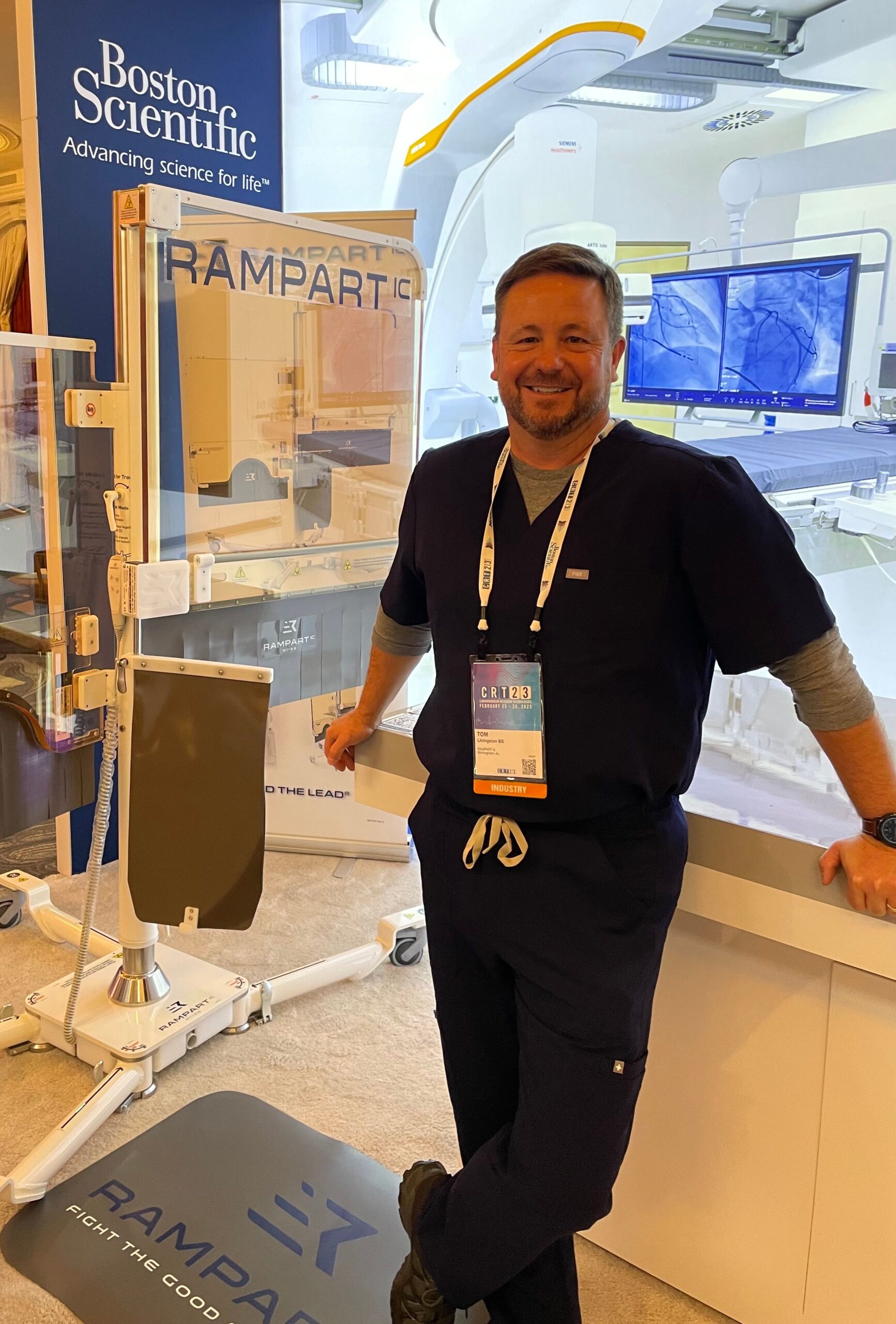
Paragraph
What if your next business idea wasn’t about making millions—but helping just one person? In this episode, Tom Livingston, CEO of Rampart IC, shares how a late-night phone call from a friend sparked the idea for a life-saving medical device—and how that simple act of service grew into a globally distributed, 8-figure company. From sketching concepts on a napkin to testing a prototype during a secret cabin weekend, Tom’s journey is a masterclass in purpose-driven leadership, calculated risk, and building something that truly matters.
Whether you’re burning the midnight oil on your own big idea or still in the dreaming phase, this conversation is for you. Tom opens up about building the company while working full time, the coffee table pact that changed everything, and the power of building a team rooted in belief, not just ambition. This is a story of faith, uncertainty, and the quiet courage it takes to bet on what doesn’t exist—yet.
APPLE PODCASTS | SPOTIFY
Press play for the full interview or keep reading below!
- [00:00]: Welcome and Introduction
- [01:27]: Meet Tom Livingston: CEO of Rampart IC
- [03:40]: What Rampart IC Does and How It Started
- [06:00]: Dr. Bob’s Injury and the Birth of an Idea
- [09:45]: Early Sketches, Late Nights, and Prototyping
- [14:21]: From Butcher Paper to Proof of Concept
- [17:32]: Testing Weekend That Changed Everything
- [20:12]: Building a Market-Ready Product
- [22:43]: Taking the Leap: Going Full-Time
- [25:30]: Pricing, Missteps, and Scaling a Business
- [29:45]: Growth After 2020 and Global Expansion
- [34:01]: The Most Rewarding and Challenging Aspects
- [36:40]: Navigating Doubt and Building the Right Team
- [38:33]: Money as a Tool, Not a Measuring Stick
- [40:49]: Balancing Work, Life, and Leadership
- [43:02]: Partnering with a Best Friend in Business
- [45:44]: Embarrassing Moments and Lessons Learned
- [49:22]: Big Wins and Key Opinion Leader Support
- [51:26]: Best Advice Received: Be Authentic
- [54:53]: Favorite Resources: EOS and Working Genius
- [01:00:50]: Final Reflection: What Tom Would Tell Himself Then
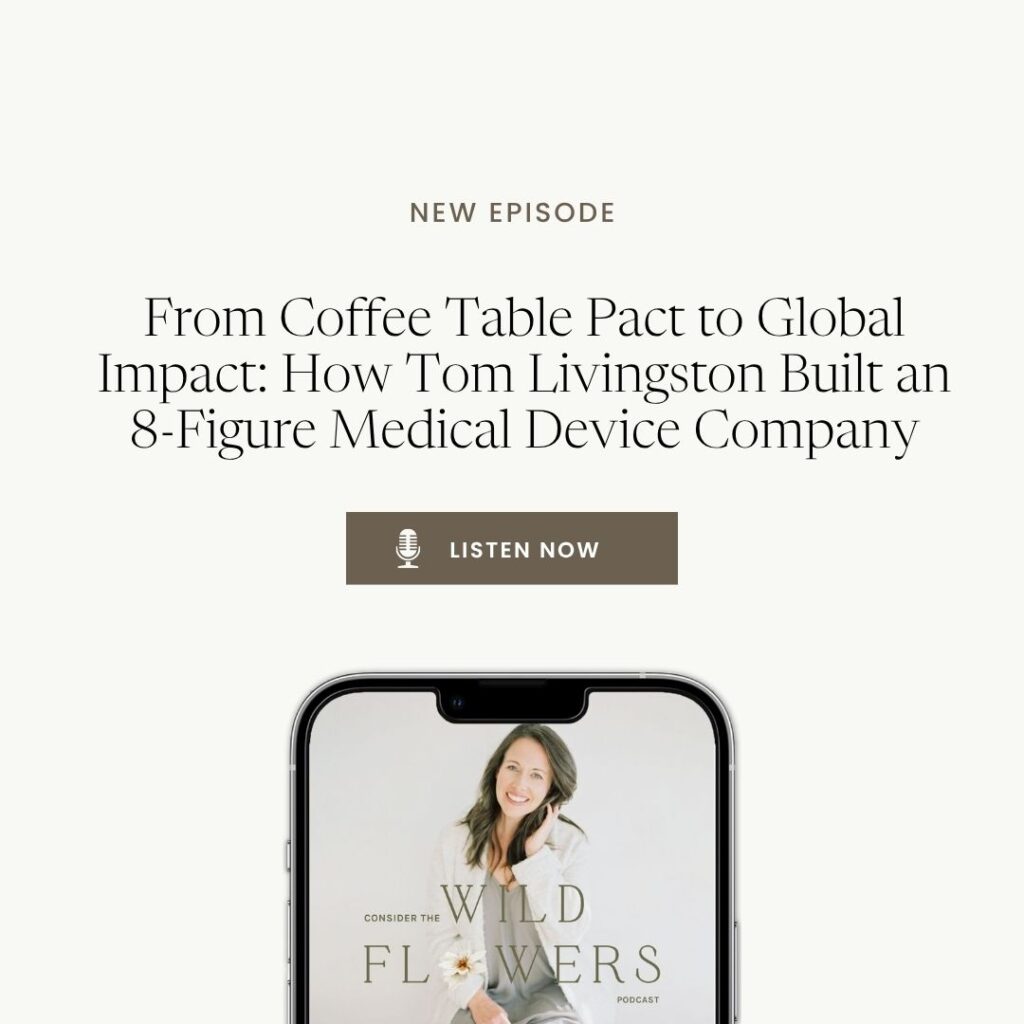
Introducing Rampart IC: A Mission-Driven Approach to Radiation Protection in Healthcare
It’s great to be here. A lot of this, honestly, I’m doing for Lauren. Sharing the story is exciting—but yeah, she was a godsend for us too.. And now you’ve got me on the verge of tears before we even kick things off. But anyway, yeah, a lot of love for Lauren here, no doubt—so much. I’m looking forward to it, Shanna. I’m excited. I’ve heard a lot about you and what you do, and I’m excited to share my story if that helps in any way.
Sure, yeah, absolutely. So today, I am chief cook and bottle washer for a company called Rampart IC. Some people call it CEO, but I’ve been doing that—I was team member number one—going back to 2018. In my role today, I lead the company. It’s an eight-figure company and growing. We sell direct in the U.S., and we have 13 distributors across the globe that represent about 60 countries we currently sell into. We’ve got a team of about 30, and I lead all functions of the company.
I’m incredibly blessed to have a great team that supports the work we do. Our product is a radiation protection device, and we operate in healthcare—specifically in what’s called the cath lab, or catheterization lab—where a lot of radiation is used during procedures. That brings a lot of risk, both from radiation exposure and from orthopedic strain caused by wearing heavy lead aprons. So, we sell this device—which is now becoming a portfolio of devices—all over the world to help protect people. It’s a great business with a great team, and we get to help people every day.
The Origin Story of Tom Livingston: A Friendship, a Family Tie, and a Life-Altering Idea
Yeah, I think we officially formed the company in 2018. I came on as team member number one in the fall of that year. We just passed our anniversary—November 1st was the day we took the leap and got started. So, yeah, it’s been six years now. It’s kind of crazy to think about, honestly.
It wasn’t my need, and it definitely wasn’t my idea in terms of the original concept. One of my best friends at the time, Dr. Bob Foster, he actually had the idea. It became a bit of a family business, too, because my daughter Lauren, my youngest, married his youngest. So there’s that connection, but that happened after we started the business. We always joke that it wasn’t an arranged marriage, as far as they know! (That’s a joke, just to be clear.)
So Bob had a real need and a concept—he was at a really dark point in his career and thought he was about to lose it altogether. He called me and said, “Hey, I just need some help. As a friend, as an engineer, a patent guy, a business guy—maybe even a coach. I just need to get back in the lab, and I don’t want to lose my career.” That’s really how it all started.
Back in 2014, he suffered his second disc rupture—just cumulative trauma from years of wearing those heavy lead aprons for his job. He was probably the top interventional cardiologist in Alabama at the time, so losing his ability to perform procedures was devastating, not just for him, but for his patients, his practice, and the hospital where he worked. He had paralysis in his right leg and didn’t know if he’d ever be able to get back into the lab again. It was a really tough time.
Tom Livingston From Engineer to Entrepreneur: The Path That Led to Rampart IC
I tell people all the time—truly a jack of all trades, master of none. I’ve been labeled as an engineer sometimes, which is probably unfair to real engineers. I studied industrial engineering at Mississippi State University, which is actually where Jeannie and I met. I had worked as an engineer for about a year, but I pretty quickly gravitated toward team leadership, business leadership, and manufacturing operations. Early on, I had some folks who saw that passion in me and wanted to help me grow in that direction. So I really only worked in a traditional engineering role for about a year before moving into leadership.
My sister’s an aerospace engineer, and my dad’s a mechanical engineer. His twin brother is an electrical engineer. Most of them definitely went the technical expert route, spending the majority of their careers on engineering projects. But depending on where you are and what opportunities arise, I think you can weave in and out of technical work and team or project leadership. And honestly, even when you step away from engineering roles, the mindset doesn’t really leave you. Once you’re an engineer, that way of thinking is kind of hard to shake.
And even on the business side, people laugh—I engineer the business, the finances. When people ask me about money, we might talk about that later, but I take a very pragmatic, engineering approach to it. That logical thinking has really served us well. I talk about common sense a lot—common sense in a world where common sense has become a superpower. And I think engineers, in many cases, develop that in spades.
I think in those early days, Shanna, I wasn’t thinking like an engineer at all. This was someone I loved dearly who was in a really tough spot—any of us would’ve been. At that point, it wasn’t about a device. It was about love and support for a friend. We just wanted to find a way to get him back into the lab.
So in the beginning, it was literally the two of us sitting at his dining room table with a Vanity Fair napkin and a pencil—some tears and some prayer, honestly. That’s really how it all started.
From there, we began asking: What’s the concept? What are we trying to accomplish? How do we, and I’ll try not to get too technical here, but how do we put as much attenuating material as possible between the dangerous energy source and the team that’s doing the work, and then teach the team how to work in the shadow of that protection?
That was the start. But keep in mind, I had a full-time job, and Bob was trying to heal, just get back to doing clinic work at that point. Neither of us had much spare time. So we started looking for and engaging people around the Birmingham area, where we were starting the business, to help us move the concept forward.
Tom Livingston: From Concept to Commitment—Funding the Vision and Building a Product
Fortunately, we connected with some fantastic people—really great, incredibly supportive folks who were excited about the idea. Whether we were led to them or they were led to us, it just worked. We collaborated with them for several years. One of the key people from that early process now works for us full time. Those relationships go deep and way back.
And honestly, that’s where the engineering mindset really kicked in—not just in terms of design, but in terms of process. We asked ourselves: How are we going to tackle this project? How are we going to solve this problem? That process-oriented thinking came from the engineering side.
When we started talking about funding, I told Bob, “This could get expensive. We don’t know how expensive yet, and we don’t even know exactly what we’re developing or who we’re going to need to help us. How are we going to do it?”
And Bob said, “I’m going to fund it.”
I told him, “That worries me. What if you end up spending a huge amount—six or even seven figures—and at the end of the day, it’s not a business? What if all it does is get you back in the lab?”
(And for the record, there was a lot of naivety on my part at that point. I didn’t understand the med device world yet.)
But as serious as he could be, Bob looked at me and said, “If I spend that money and I get back in the lab and I get my career back, then that’s a great return on investment.”
That moment really helped me understand two things: first, his deep resolve to solve the problem, and second, just how big this problem—and this potential business—could be.
Now, when we look at what we call the TAM, or total addressable market, that’s why we see the potential for this to be an $11 billion global opportunity. There are so many labs out there, and so many people working in these hazardous conditions. So that was the funding story.
From Napkin Sketches to Validation: The Long Road to a Working Concept
We knew in 2014, as we’re sketching something out—literally just squares on a napkin—we knew it was a physical device then. At that point, there was no way to know if it would become a business. The device’s appearance, materials, and overall design were still completely unknown to us.
I would say we thought there was a solution in the market that Bob gravitated toward in 2015—his hospital bought it for him—it didn’t work. So in 2016, he came back and said, “Hey, we tried this. It didn’t work, but I’ve learned some things from it.” And so at that point, we engaged an industrial designer—again, just the talent that was brought to us—in Birmingham. And we started explaining the concept, and literally he would roll out, Shanna, butcher paper across this big table, and he would just start sketching. “So what about this?” “Nope, that’s not it.” “What about this?”
And so we began to have this incredibly creative, iterative, almost artistic approach to what was a device. But it was at that point—probably sometime in 2016—that we started seeing this. Again, remember, this is most of the time two nights a week, from six to nine o’clock at night, in an office somewhere—not at home.
It was corn chips and salsa for dinner. As we’re working through this, and again, that guy was incredibly patient in meeting us where we were. That’s something we talk about an awful lot—our availability was in the evening, at night. And so he was excited about it—and excited enough about it to be able to do that with us at that time.
Probably one of the most exciting times for us—it’s curious—was spring of 2018. So we started really sketching this out, let’s just call it mid-2016. By the spring of 2018—so right at two years, maybe a little bit less than two years later—again, working at it part-time, trying to figure some stuff out, we had a—I don’t want to call it a prototype, because it wasn’t a prototype—but it was something that held these panels, these attenuating panels, in a way that we thought made sense.
We rented out a lab secretly in North Alabama somewhere. I mean, again, everything was—I was the master of nondisclosure agreements at that point. I wouldn’t have any conversations with anybody without doing that. But we rented out a lab—it was in secret—we put this device in place, and it was a big weekend. It was one of those weekends where, as we brought in the physicists, as we brought in the engineers, as we were putting this device in—and we started—we call it “pressing the pedal,” turning on the radiation—as we started pressing the pedal, it was either going to be: the concept works, and we felt like it would—I mean, it’s common sense—but it was either going to work and something was going to happen after that, or it wasn’t, and we were going to fold up shop.
The Weekend That Changed Everything for Tom Livingston: Testing the Concept
So it was a pretty scary weekend. We were staying at a cabin at a state park nearby—Bob, Jenny I, my wife, and Bob and Donna. We were all in the cabin together, talking through everything as it was unfolding. So you can imagine the drama. As they’re doing the test—yeah, absolutely.
We were all in the lab during the day, and then we’d go back to the cabin at night to share with Donna and Jenny how things were going. I’m sure they were nervous as well. But that weekend, we knew—hey, this will work. It’s going to work. We’ve figured something out.
And the scary thing at that point was—we hadn’t really thought beyond that weekend. You don’t want to invest a ton of time, effort, energy, resources, and emotion if you don’t even know whether the concept is going to work. So here we were, over two years in, just figuring out: this might work. Well, it will work. And from there, we were just trying to figure out the path forward.
We were definitely friends before all of this. Our families were friends—we went to the same church, lived in the same neighborhood, taught Sunday school together. My oldest daughter and his middle son dated and went to the same college. All the kids were part of the same youth group. So there was already a lot of connectivity between our families.
But this took it to a whole other level. And then, of course, Lauren and Thomas’s wedding took it to yet another level. But this process definitely brought us even closer, talking to each other literally every single day, six or seven days a week.
Tom Livingston: From Proof to Product—Going All In on a Med Device Startup
Yeah, “I can’t imagine medical devices”—there are some embarrassing moments there! Maybe we’ll touch on that a little later.
But for me, the next thought was: okay, we’ve got this concept and we’ve proven it. But we didn’t yet have an intuitive, elegant way to move these panels in, move them out, or adjust them as needed. We were really testing the configuration of the material, I think, as much as anything else.
So immediately, my mind went to: “All right, we know hanging the panels this way works. Now how do we do that in a way that’s intuitive, that’s elegant, that fits well in the cath lab—something people actually want to work with?” That’s where I went next from an engineering perspective.
What we started learning after that, Shanna, was—even that was a lot of work.
I remember Bob and I sitting down at a coffee shop one day. I was at a point in my full-time job where I thought, If I’m going to take a risk, now’s the time. It was a small window—probably a divine one, honestly—but a real window in time. I told Bob, “Hey, this either has to fail fast or we’ve got to make it work fast.” We didn’t have a lot of funds, and we didn’t have a lot of time.
I could take you back to the exact coffee table in Birmingham where we sat, looked at each other, and said, “We’re going. We’re all in.” I was all in from a career perspective. Bob was all in financially—he was supporting it at that point. And we had not done any fundraising yet. No outside investment, no capital raised. Which—just getting it to that point without fundraising—is absolutely crazy in the med device world.
Absolutely crazy.
So in the fall of 2018, I transitioned into this full-time. All the stuff you’d imagine from an entrepreneur—that was our world. We were open-nesters at the time, so that made it a little easier to take some of those risks.
From fall of 2018 to fall of 2019, we went from we have a prototype to we have a commercially viable device that we sold to our first hospital in fall of 2019.
And at that point, we were setting ourselves up for what we thought was going to be a crazy, unbelievable year in 2020.
You can imagine what happened in 2020 with med devices. But still, in a year’s time, we went from concept to commercially viable product—in the med device world. Completely unheard of.
Learning on the Fly: Confidence, Calling, and the Unknown
I’ll say this: I think there are times—if we look back on it—if we had known everything we were going to have to go through, we might not have done it.
So there was probably some confidence, maybe even arrogance, on my part—thinking, “Hey, I know how to design stuff, get stuff built, we’ll figure this out.” I’ve always been kind of a “figure-it-out” guy.
What I didn’t know at that point was how much I didn’t know. And that’s probably one of the more embarrassing parts. There are some funny stories there, for sure. But I think at that point—remember—we entered into this with a lot of tears and a lot of prayer. We felt like this was a calling—not just for Bob, but for all the people out there who were hurting and suffering, and for how many more would be in the future.
So we didn’t feel like we had much of a choice, quite honestly. From my perspective, career-wise, I’d burned the boats.
It had to work. We had limited time, limited resources—so it had to work.
Looking back over that period, I’d say we had some great people who were part of the project. They were incredibly excited and supported us in ways I can’t even begin to describe. But I’d also say there was a little bit of divine protection through that process that helped us get where we needed to be.
Tom Livingston: The First Year—Pricing, Missteps, and Building a Real Business
So, the first year—remember, I’m a math guy. So the business side of it—the pricing, figuring out gross margins—that’s not hard for me. I actually really enjoy that, and it’s pretty easy.
What was hard was figuring out how we were going to structure the business. From a commercial perspective, how are we going to sell this device?
We truly thought, Shanna—and we were wrong—but we thought this device was so intuitive and so easy to use that we would be creating these things up—and they’re not inexpensive, right? We’re talking about six figures for a device that goes into a room to protect the team. But we thought we’d crate them up, deliver them to the hospital, post some videos online on how to use it, and the team would unpack it, watch the videos, and learn how to use it.
That’s what we thought. That’s what we did.
And we quickly realized—that’s what we did—but we’d also been thinking about it for five years.
So when you think about injecting a relatively large, expensive piece of equipment into the workflow of a cath lab—with a team that already has an orchestrated dance, highly skilled people doing incredibly complex things inside the human body—it was just incredibly naive on our part.
We had priced the product based on that “crate and ship” model with a video. But over time, we had to raise the price—I’d say by 40%—just to cover what turned out to be a completely different commercial process.
That process now includes a full clinical team and a sales team out in the field. We do in-person demos, product launches, follow-up visits, and continuing education for these labs after the product has been sold and installed. It’s a completely different business model and structure than we originally imagined.
So the easy part was doing the math—I could plug in numbers. The hard part was coming up with the right model for how the business actually needed to function.
We were breaking paradigms. The 100-year-old standard for protecting people in the cath lab has been the lead apron. That’s the norm. That’s our competition.
And we had no idea at the time just how big of a challenge breaking that paradigm would be—or what kind of team it would take to do it.
What’s Next for Tom Livingston: Growth, Product Evolution, and Impacting Lives
At this point, we have hundreds of devices all over the world, which is really exciting. And the device has a disposable component as well, so once someone buys a device, the relationship doesn’t end there. For every case they perform using that device, there’s a sterile drape that goes on it. So we’re also providing that sterile drape—for every single case.
It’s a great business model, but more importantly, it’s a great way for us to stay connected to our customers. And we have to stay connected because of that recurring use. That’s a huge part of our growth, too.
So yes—hundreds of devices, disposable components, all over the planet—and we’re hearing unbelievable stories. I want to share one with you that connects where we are now with where we’re going.
There’s a KOL—a key opinion leader—who’s a star interventional cardiologist in York, Pennsylvania. She’s on our medical advisory board. Her story is incredible and very different from Bob’s.
Bob’s story was, I’m hurt, I’m injured, and I need to get back in the lab. Her story was different. She’s young and felt called to be a mom. And we often talk about how we’re made for “works”—plural. That “S” is important. We’re not made to do just one thing. She was made to be a CTO operator—an interventional cardiologist doing some of the most difficult procedures, with lots of radiation, long hours in the lab, and heavy apron wear. But she was also made to be a wife and a mom.
It was really cool—when we started talking to her, she said, “Because of Rampart and what you’re doing—and what you’re going to be doing—I can do both. And I can do both really, really well.”
That’s the fuel that keeps us going.
So today, we’ve gone from having one product—which as a CEO, when you put your head on the pillow at night, and you’ve only got one product, it’s hard. You think, What if someone out-designs us? What if something happens to this product?—to now having a product portfolio.
At our most recent conference, we had six products on display. We launched three brand-new products. And our next big device—which is even more sophisticated than the first—is in evaluation this week with Dr. Davies in Pennsylvania.
That product does some different things, works with different cases, and broadens the scope of who and what we can protect. We’re going from covering just the majority of cases she performs to covering 98–99% of them, getting her out of the lead, providing better radiation protection, and giving her peace of mind.
It gives her confidence that she can be there—physically and emotionally her family for decades to come, while also being there for her patients and her team.
So that’s what’s next for us: continuing to evolve and iterate with the momentum we have, and adapting to a changing market. We’re moving toward offering multiple products and complete solution suites.
We talk a lot about meeting people where they are. It’s no longer. Here’s the Rampart device. Let us show you how to use it. Now, it’s Show us your cath lab, tell us what goals you’re trying to accomplish, what your budget is, and let us bring you a suite of products to help you reach those goals, not just your clinical goals, but your personal and life goals too.
That’s what’s happening now, and that’s what’s next.
Tom Livingston on the Most Rewarding—and Most Challenging—Parts of the Journey
The good outweighs the tough part exponentially at this point, so I’ll start there.
Whenever you get to lean into what you feel like your calling is—and into your gifting—that’s incredibly rewarding. We say a lot around here: Your calling is where your gifting and your burdens collide. And I would say now, my burden has really become those in the cath lab who are hurting—or about to be hurting and they know it. They’re exposed; it’s a dangerous environment. And the new folks coming into the lab—they deserve better protection. They deserve to be comfortable.
They’re saving people’s lives—and yet, they’re in harm’s way while doing it. To be able to be part of a company that’s full of integrity, committed to doing this the right way with the right team—that’s incredibly humbling. And honestly, just getting to work with the team we have every day is so much fun and deeply rewarding.
That’s the good stuff.
Now, the struggle? The biggest challenge is honestly… me. I’m very much wired to solve the unsolved—today. If something’s not done, I want to get it done now. That urgency, that drive—it can be hard to manage. And everyone who knows me, lives with me, or loves me—they all know it’s something I’m still working on.
It’s a balance. When we’re called to something, we don’t often get to define the terms of how comfortable that calling will be. We’re just called to get the work done.
At the same time, we have to do it in a way that’s healthy and sustainable. That “S” in “works” is important—I’m not just called to be the CEO of Rampart or to help lead a team that’s making a difference around the world. I’m also called to be Lauren’s dad, Hannah’s dad, and Jenny’s husband.
Not getting lost in any one of those roles—that’s the real challenge. And I think that’s true for anyone who loves what they do, feels called to what they do, and is passionate about their work. Figuring that out, and giving yourself some grace along the way—that’s the hardest part for me.
Tom Livingston on Navigating Self-Doubt: Equipping Yourself Through Faith and Team
You put your head on your pillow at night, and I think anyone who’s being completely honest with themselves would say that if the things you’re doing don’t scare you a little bit, maybe you’re not stretching far enough. And quite honestly, the things we’re doing ought to scare us a little. I heard someone say recently—maybe even on this podcast—“No pressure, no diamonds.”
Exactly.
So yeah, there ought to be things in front of us that we don’t feel fully equipped to do. Because if we’re already equipped to do everything it takes to be successful, then where’s the God thing in that? Where’s the growth? Where’s the adventure?
So yes—there are definitely doubts, and I think that’s a normal part of the process. There are different ways to handle that, and I’ll try not to step too far into the pulpit here, but I will say—it’s so important to find the right team.
To bring people into the company who are aligned with the mission, who want to be part of it, and who are diverse, not just in skill sets, but in perspective. That makes a big difference. It makes it a little easier to rest at night knowing you’re not doing this alone.
And I do realize I’m fortunate—I’m part of a business where we have a team. There are a lot of entrepreneurs out there who are running one- or two-person businesses. They don’t have that luxury. And I really admire those folks. That’s incredible.
They’ve got to have an incredible support structure around them, and often, it’s an unpaid support structure. In my case, I’m fortunate to be able to pay mine. So I have a lot of respect for those solo founders and small teams doing it all.
Money, Pressure, and Pursuing Harmony
This’ll shock you—(sarcasm implied)—but I’m pretty pragmatic in how I approach money. For me, money is a tool. It’s a tool to help accomplish the mission. Whether in business or in many cases, even personally.
And I think the big thing with money is—once it becomes a measuring stick, then you’re in trouble. Typically, bad things follow that. I want to be clear here: I don’t think money is bad. But I do think money reveals the heart. That’s something we talk about often. And not just on the personal side—it applies to business too.
When you’re stressed because you don’t have money, it reveals the heart. When profits are great and cash flow is strong—it reveals the heart. So from a money perspective, I think that’s probably been the biggest learning for me.
I mentioned earlier—giving grace to myself when I don’t. And it’s not just now as an entrepreneur. Even when I worked for entrepreneurs or investors in the past, the pressure to deliver a great return on investment—that might’ve been even more intense for me than what I’m doing now.
But what I’m learning to do, Shanna, is to take what we call a “clarity break.” We use EOS—the Entrepreneurial Operating System—and clarity breaks are a part of that. I’m learning to listen to my mind and my body a little more than I used to.
If I’m feeling frustrated, I need to recognize that and do something about it—stand up, take Belle (our dog) for a walk, go shoot a round of sporting clays—whatever gives me a moment of perspective.
Like I said earlier, I struggle when things aren’t done. I’m incredibly driven. I want to get it done now. But I’m learning that sometimes to get it done well, you have to pause. You need clarity and perspective.
I’m also fortunate to have a wife who will sit with me on the back porch and watch the sunset, and then look over and say, “Hey, are you okay? You’re not saying anything—all your conversations are happening in your head right now.” Being called out like that—it’s helpful.
It also helps when one of your best friends is your business partner. We hold each other accountable—to doing things the right way, and to maintaining some kind of work-life balance.
And when I talk about work-life balance, for me that means: being fully engaged at work when I’m at work, and being fully engaged in life when I’m doing life. Now, that’s hard. Incredibly hard. But that’s the goal—and I try to give myself grace when I don’t do it well.
Tom Livingston on Partnership, Balance, and the Power of Complementary Strengths
I can have a lot of edge. I can be pretty intense—very goal-oriented. Patience? Most people who know me wouldn’t say I have a lot of it. So all the things I struggle with and am working on to be a better human—he’s already there. And that helps a ton.
That’s made it a lot easier. I don’t know that I could do this with another me—if that makes sense. That just wouldn’t have worked. We wouldn’t have complemented each other. We might’ve come up with some really cool stuff, but we would’ve burned out pretty quickly.
Fortunately for me, my business partner, Dr. Bob, is someone a few of us in the company talk about all the time—we say, “That’s what I want to be when I grow up.” He’s honestly made this easy.
And again, how do we find balance and harmony in that? Both are incredibly important. And how do we find that balance?
We’re created and knit together differently for very specific purposes—but yeah, I’d love to have more of that peace and calm than I naturally do. Fortunately, I get to hang out with it a little. Rub shoulders with it a bit. And it helps.
Tom Livingston’s Most Embarrassing Lesson—and How It Became a Defining Moment
And I’ve alluded to this a little bit already—but how much I didn’t know about med device when I got into this business.
I’ll share a really quick story. Hopefully, my competition won’t use it against me if they ever hear this. But the Rampart device itself was ready to go—we were within 30 to 60 days of putting it into a hospital and actually using it with patients and healthcare teams.
And at some point, someone asked, “Hey, so what are we going to do to drape this?”
And I was like, “What do you mean—drape it? Help me understand.”
Keep in mind, I had a full-time job through most of this. I hadn’t seen many real cases, didn’t really know what the day-to-day in the lab looked like. I was going off of word-of-mouth and what worked in our testing environment—which was done with phantoms, not real patients.
But once you put this over a patient during a procedure, it’s got to be sterile. You need to cover it with a sterile drape.
Our device is tricky. It moves, it’s dynamic, it adjusts—so you can’t just throw a sheet over it. It needs a specifically designed drape.
Once I got over the initial embarrassment—How did I not know this?!—I started calling around. And remember, we’re 60 days out from live use. The first person I called said, “Yeah, that’s about a 12-month lead time, and it’ll cost you hundreds of thousands in development.”
So I went from embarrassed to scared to death.
Fortunately, we were led to the right person—or they were led to us. Either way, we found a great partner. And somehow, we turned what’s normally a six- to twelve-month project into two months. We had sterile drapes ready.
And now, it’s a huge part of our business. Yes, it’s a revenue stream, but more importantly, that design is essential. It takes less than two minutes to drape the device, which is incredibly important in emergent care—like when a patient is rolling in with a heart attack.
So yeah—pretty embarrassing. But also a defining moment.
Tom Livingston on Regret, Growth, and the Lessons That Build Character
No—and you just said it, right? Actually, this is the perfect segue.
So no, there’s nothing I wish I would’ve done over. There are definitely some things I wish I had done right the first time—but not done differently altogether.
The reason I say that is—you just alluded to it—it’s those learning moments that help us build muscle. They build character. They help us realize our potential. And honestly, they keep us incredibly humble.
Without some of those moments, we’re not who we are today. We don’t become high-character people with grit and tenacity because of all the easy things we’ve done. We get that from the hard lessons—the bad calls, the mistakes, the things we wish we’d seen more clearly in the moment.
So no, I wouldn’t wish any of those away. I just wish I’d made a better decision at the time in a few of them.
Big Wins and Defining Moments for Tom Livingston
I’d say there are a couple of standout moments.
Earlier in the podcast—spring of 2018—there was this “oh my gosh, this actually works” moment. So much had built up to that point. I don’t know if it was a “pinch me” moment as much as a sigh of relief. One of my best friends in the world had invested his own money into this, and now it looked like it actually could work. That was a big deal.
Another moment came in early 2021. By then, we had what we call KOLs—Key Opinion Leaders—some of the rock stars of interventional cardiology who had heard about our device. Part of that was due to the team we had hired—people who got behind our mission. Some were hurting themselves, and others saw this work as part of the legacy they wanted to leave.
So there we were—2021 heading into 2022—and I’m watching live cases, some of the most challenging ones, being performed by those KOLs. These cases were being broadcast around the world, and instead of just talking about the procedures, they were talking about this really cool radiation protection device they were using. They said things like, “This is the first night I’ll go home without needing ibuprofen and two glasses of wine just to lay down on the couch and recover so I can go back to work tomorrow.”
That was incredible. That wasn’t just “this could work.” That was “this is going to work.”
We had people like Bill Lombardi and Bill Nicholson saying, “This is incredibly important, and I want to take this to my peers across the globe.”
Tom Livingston on Feedback and the Turning Point of Authenticity
In my line of work, we call it feedback—and feedback is a gift, even if it doesn’t feel like it in the moment.
I remember working for Target, which is a great company for business development and leadership. I was part of an accelerated development program and got some really tough feedback—one of those hammer-over-the-head moments. The message was: “Tom, you’re working so hard to figure out what people want from you and give it to them, instead of just being your authentic self.” Words like, “You’re being political,” and “You’re not getting to the truth” came up.
The person delivering that message was a professional. He knew that for someone like me, it had to sting a little to sink in—and it did.
The advice was simple but powerful: Just be you. Be your authentic self. There’s only one you. Stop worrying so much about keeping up or saying what others want to hear.
That was a turning point. Some of that goes back to how I was raised, and how I’m wired. But from that point on, I’ve gone out of my way to be direct and authentic. People who work with me now probably wouldn’t guess that authenticity was ever something I struggled with.
Now, you can call me a lot of things—but “not authentic” isn’t one of them. That said, it’s still something I work on. Some people are just naturally confident in who they are and don’t carry that filter or worry. I’ve had to learn it.
And yes—I do worry about how I’m perceived. I worry if I’m giving someone what they need, and whether I’m delivering the message in a way they can digest. Sometimes, I just need to give them the message—clearly and directly.
That’s something I have to be really careful about. Especially as a CEO, with a team depending on me.
What is Tom Livingston working on now, or one resource you would like to share?
So I had two resources to share.
We run our company on EOS—Entrepreneurial Operating System. And again, it’s probably in some ways maybe the engineer’s way of running a company, but it’s a method. It’s developed by a guy by the name of Gino Wickman.
Get a Grip on Your Business, Traction. And the whole concept of EOS is that we’re going to take the business and we’re going to slice it into six components. And if we can make those six components healthy and strong, we’re going to make the business strong.
Now, that’s aside from—you can’t have a bad product and have six great components. You’ve still got to have a great product. But whether that’s vision, people, data, issues, process, and then traction—which is kind of the discipline of how you run your company.
And so we’ve run EOS since day one. I was a coach in the past in that—in a prior life with a company that I was in, we brought that in, and that’s where I learned the system there. And so that’s a resource I would share with folks. And there are parts of it you can do partially that would be helpful, but as a system, it’s designed to work together, and it can be really powerful for folks that are trying to figure out how do I build a foundation and find a way to scale something that, at the end of the day, is going to be bigger than me.
You can certainly self-implement. You can—most likely, I mean, I think it’s so dadgum popular now—I think you can just about find a coach in any city in the country if you Google that or whatever. But I would read the book. There’s a book called What the Heck Is EOS?, and that’s a much easier read for folks who are going, “Hey, is this something that might be for me?” So you can read that, and if that makes sense for you and resonates, then I’d go to Traction: Get a Grip on Your Business. And if that really resonates, then you can kind of decide, “Hey, is this something I want to invest in to help me run my company?”
I couldn’t do what I do without that system.
I had two lined up, so based on time, we don’t have to do the second one—so we’re good.
It’s Working Geniusby Patrick Lencioni.
Oh my goodness. That could be a separate podcast in and of itself. So, Patrick Lencioni—two of his books are part of EOS: The Four Obsessions of an Extraordinary Executive and The Five Dysfunctions of a Team.
Working Genius is a tool and an assessment that helps us determine what are our working geniuses—what brings us life at work. It’s six components, and typically—almost always—there are two that are working genius, two that are working frustrations, and two that are in the middle.
The six components—if you think of the word “widget”:
-
Wonder, which identifies the need for improvement or change. That’s the person who says, “What if?” or “Have we ever thought about doing it this way?”
-
Invention, which confirms the importance of that need and helps generate the idea or solution.
-
Discernment, which assesses the merit of the idea.
-
Galvanizing, which generates enthusiasm and action around the idea.
-
Enablementinitiates, supports, and assists in the implementation of the idea.
-
And the last one is Tenacity—that person that commits to ensuring that the idea or solution gets done.
Through assessments, you can take everybody in the workforce—and again, this is a work thing, although it does speak a little to personal—and begin to put maps together for solution teams and those kinds of things. You actively consider diverse perspectives and every element from concept to execution, whether across the company or within smaller work teams.
You wouldn’t want everybody in a company, for example, to be a Wonder person. Somebody’s got to get it done. Somebody’s got to galvanize the team—those kinds of things.
So that’s been a lot of fun. Very inexpensive tool. Patrick Lencioni is great, and it’s just one of his tools that I love.
Tom Livingston Looking Back on The Unexpected Journey
There’s a ton, right? And I think this perspective is powerful for everybody—to go back to that day. It’s about accepting that the path you’re about to walk—the journey you think lies in front of you—is going to be very, very different from what you think today. And that’s okay. In fact, it almost certainly will be.
I think so many times, through our faith, we’re only given enough light to see the next step. Even though some of us want to map out the whole trip ahead of time—me included.
But as we get into it, we start to realize that the trip we mapped out isn’t the one designed for us. That’s not the way the solution is going to unfold. And for someone with my personality, that can be frustrating. Or—you can learn to iterate, give yourself some grace, and accept that truth.
It sounds cliché, right? It’s about the journey, not the destination. But that’s real. That’s part of what makes you who you are.
Looking back now, I’d say—we’ve impacted more people than I ever thought we would. There are more stories tied to this than I could have imagined. And that includes not just the teams we’re helping in hospitals, but the team we have inside the company.
We really want to empower people to live in their gifting. That’s really what we’re all about—not just with our customers, but with our team. So when I think about that Vanity Fair napkin at the table that day—and what I imagined back then—it’s completely different now. But it’s turned into this huge focus and passion point: to plug people into what they were created to do.
Completely different—but much more beautiful. Much more painful in some cases, too. But definitely much more beautiful.
Tom Livingston
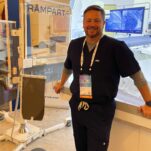 Tom Livingston is the CEO of Rampart IC, a mission-driven medical device company protecting healthcare workers around the globe. A lifelong problem-solver with a background in engineering and business leadership, Tom never imagined he’d one day lead an eight-figure global company born from a conversation at a kitchen table. But when a close friend and interventional cardiologist was on the brink of losing his career due to radiation-related injury, Tom’s instinct to serve, build, and protect kicked into gear.
Tom Livingston is the CEO of Rampart IC, a mission-driven medical device company protecting healthcare workers around the globe. A lifelong problem-solver with a background in engineering and business leadership, Tom never imagined he’d one day lead an eight-figure global company born from a conversation at a kitchen table. But when a close friend and interventional cardiologist was on the brink of losing his career due to radiation-related injury, Tom’s instinct to serve, build, and protect kicked into gear.
Today, Rampart IC is not just changing how cath labs operate—it’s giving healthcare professionals their quality of life back. Under Tom’s leadership, the company has expanded into a suite of products that serve a powerful mission: protecting those who save lives. With authenticity, grit, and a whole lot of humility, Tom continues to champion purpose-driven innovation—and remind us that some of the most impactful businesses are born from personal pain, bold friendship, and a deep sense of calling.
May 15, 2025
Previous Post:
Next Post:
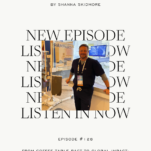
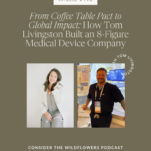
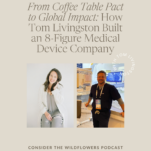
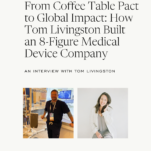
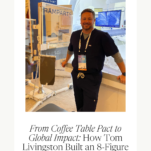

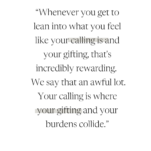
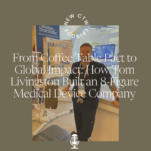
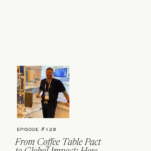
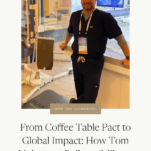

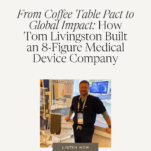
And if you found this helpful, share with your friends!